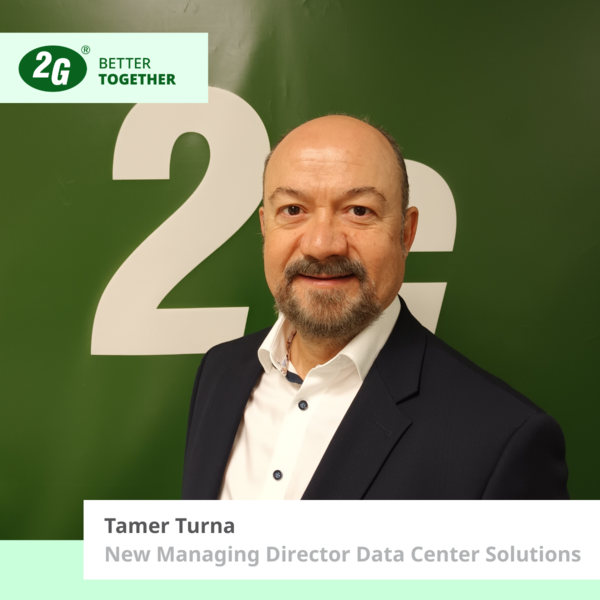New Managing Director Data Center Solutions: Welcome Tamer Turna
August 12, 2025

How did you experience the first weeks at 2G?
Tamer Turna: The first few weeks at 2G have been both energizing and insightful. I was warmly welcomed by a team of highly motivated and forward-thinking professionals. It's been a great opportunity to immerse myself in the company’s technology, culture, and strategic goals, especially within the context of the growing demand for sustainable energy solutions in the data center sector.
Can you briefly introduce yourself and share a bit about your professional background?
Tamer Turna: Certainly. I have over 30 years of experience in the energy and infrastructure sectors, with a particular focus on distributed energy systems, sustainable technologies, and mission-critical applications. My career has included leadership roles in both corporate and startup environments, spanning Europe, North America, Latin America, Africa and APAC. I’ve worked on developing and implementing resilient energy solutions for industrial, commercial, and hyperscale clients — including several initiatives in the data center space.
What attracted you to 2G Energy and this specific role in data center solutions?
Tamer Turna: 2G Energy stands out as a true innovator in the field of high-efficiency, low-emission energy systems. What drew me to this role is the opportunity to align my background in distributed power for data centers with 2G’s vision for sustainability and innovation in mission-critical infrastructure. Data centers are at the core of the digital economy, and ensuring they’re powered reliably and sustainably is one of the most important challenges of our time.
What will be your main tasks as Managing Director Data Center Solutions at 2G?
Tamer Turna: My role involves defining and executing the go-to-market strategy for 2G’s data center solutions globally. This includes mobilizing and leveraging 2G’s existing operations in 60 countries (in sales, design – build – deliver and long-term service) for our data center solutions vertical, building strategic partnerships, guiding solution development, and ensuring our offerings meet the evolving needs of data center operators. I’ll also be working closely with our R&D, and operations teams to drive innovation and deliver tailored CHP and hybrid energy solutions that enhance uptime, efficiency, and sustainability.
What trends do you think are shaping the future of sustainable data infrastructure?
Tamer Turna: Several key trends are reshaping the landscape: the exponential growth of AI and cloud computing is dramatically increasing power demand; at the same time, operators are under pressure to decarbonize and meet ESG goals. We're also seeing a shift toward edge computing, modularity, and localized energy systems. These dynamics are driving interest in cleaner, on-site generation solutions like CHP, fuel cells, and eventually hydrogen-ready systems.
What key challenges do data centers face today when it comes to energy efficiency and resilience, and how can 2G Energy address them?
Tamer Turna: Data centers are under pressure to reduce their carbon footprint while also maintaining 24/7 uptime. The grid alone can no longer reliably support this dual objective. 2G Energy provides solutions that address both issues simultaneously — our CHP systems offer high-efficiency, on-site generation with the ability to capture and reuse waste heat, significantly improving energy utilization and system resilience.
How do you see combined heat and power (CHP) playing a role in modern data center strategies?
Tamer Turna: CHP is uniquely positioned to solve multiple challenges simultaneously: it provides reliable, on-site power while drastically improving energy efficiency by utilizing the thermal output. In colder climates, recovered heat can support facility heating or absorption cooling; in warmer regions, it can reduce dependency on traditional HVAC. CHP also provides grid independence and can be configured to run on renewable gases, making it a future-proof solution.
What is your vision for 2G Energy’s data center solutions over the next 3 – 5 years?
Tamer Turna: Our vision is to establish 2G as a go-to partner for data centers aiming to decarbonize without compromising performance. We plan to expand our modular CHP offerings, integrate with battery and renewable systems, and introduce hydrogen-ready engines to help our clients meet long-term sustainability targets. Additionally, we aim to support AI-optimized load balancing and predictive maintenance through digital integration.
How do you plan to position 2G as a key partner for data centers seeking more sustainable and reliable power solutions?
Tamer Turna: We are focused on providing scalable, flexible, and high-efficiency solutions that directly address our clients’ operational and environmental goals. By leveraging our engineering expertise, track record in CHP, and our commitment to innovation, we can deliver customized systems that enhance uptime, lower emissions, and reduce total cost of ownership. Collaboration, transparency, and performance will be our key differentiators.
How do you see the intersection of digital transformation and energy transition affecting data centers?
Tamer Turna: Digital transformation is increasing the demand for compute power, and therefore energy. At the same time, the energy transition requires that power to be cleaner, smarter, and more decentralized. Data centers are becoming both energy consumers and producers. As a result, technologies like smart microgrids, AI-driven energy management, and real-time optimization are becoming central to their operation — and that's exactly where 2G's hybrid systems can add value.
What role does decentralization and on-site generation play in creating greener data centers, in your view?
Tamer Turna: Decentralization is essential for building resilient and sustainable data infrastructure. On-site generation reduces dependency on increasingly strained grid infrastructure and allows for better control over emissions and energy efficiency. CHP and other distributed energy resources enable data centers to become more self-reliant, efficient, and adaptable — especially in areas where grid expansion is lagging behind digital demand.

